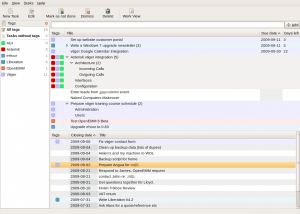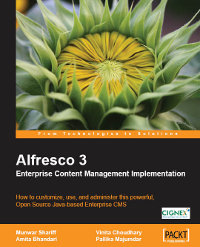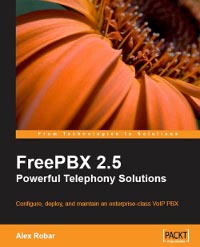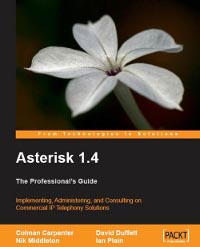More book reviews and what I’ve been up to…
I just noticed that I hadn’t posted anything here for what feels like ages – since August the 15th.
So I thought, hmmm, better write something.
But what? A quick update on what’s been going on perhaps? That’ll do…
I’ve been working quite a bit with the brilliant free and open source vtiger CRM recently. Looking at some of the less widely used features and updating our training materials for the recent 5.10 release. I’ve also just submitted a small patch for the Customer Portal feature, to do with its web layout and have been thinking about how best to improve this, and the Webforms modules, to make them easier to customise.
I am also really enjoying using a great little python application called “Getting Things Gnome“. It one of those simple applications which does one job, does it very well and is easy to use. It’s basically an app for jotting down your todo list and making sure you get things done… Here’s what it looks like on my Ubuntu Jaunty desktop:
I also had a mail from those nice people at Packt Publishing suggesting two new books to look at and review for them, In fact a co-author of one of them actually requested that Packt contact me to do a review 🙂 Flattery indeed.
So, we now have four books in the pipeline in no particular order:
Implementing, Administering, and Consulting on Commercial IP Telephony Solutions
- Written by four Asterisk Professionals, this book brings their years of experience together in an easy-to-understand guide to working with Asterisk in small, medium and larger Commercial environments
- Packed with hints, tips, and best practice – learn to avoid the pitfalls that can hinder an Asterisk implementation
- Focused chapters provide thorough, comprehensive, and self-contained instructions on how to deploy Asterisk across different commercial scenarios
This will probably be the first one I read when they arrive next week. It’s hot-off the press, just been released and can be ordered from Packt’s web site here.
My little Asus 1008HA netbook is running very happily with the Alpha build of Ubuntu Karmic Koala. I was at the swimming pool yesterday (not in it but taking my son to his lesson) and using 3G mobile internet to get on line. Battery life is good although not as long as is quoted by Asus. I reckon I get about 3 1/2 to 4hrs of good use. But that is mainly when powering a 3G dongle too – and they get hot. Karmic is shaping up to be a great release I think although to be frank I am really not sure about the new Gwibber interface, and the Empathy IM client hasn’t really floated my boat yet. But hey ho, never mind, at least we have a choice folks.
We are planning some new marketing activities over the coming months, what with the forthcoming release of the best desktop OS of all time and Microsoft releasing their rewrite of Vista, October should be a fun month. Hopefully we’ll have lots of interesting stuff to write about.
In fact I want to share with you a backup script I’ve written in Bash for my home office network and what may well end up being expanded and developed to support some of our commercial systems too. Well I think it’s pretty cool anyway. It wakes up machines in the middle of the night, uses – currently – rsync to back them up, then turns them off again. Configuration is easy and it seems to be working fine. When I get a mo I’ll publish the script source and let you all comment on my terrible bash skills. But I like it…
So there!
Asterisk: AGI Programming
Recently I received a flattering email from Packt Publishing telling me about a new book entitled: “Asterisk Gateway Interface 1.4 and 1.6 Programming” – by Nir Simionovich. The author of the email refered to this blog and asked if I would like to review their book for my blog. Very flattering indeed.
[Update: Book review is done now. You can read it here]
I was, of course, already familiar with Packt. They do produce lots of books on Open Source technologies. What I wasn’t aware of, until I looked, was this (from their “about us” page):
Packt Open Source Project Royalty Scheme
Packt believes in Open Source. When we sell a book written on an Open Source project, we pay a royalty directly to that project. As a result of purchasing one of our Open Source books, Packt will have given some of the money received to the Open Source project.
In the long term, we see ourselves and yourselves, as customers and readers of our books, as part of the Open Source ecosystem, providing sustainable revenue for the projects we publish on. Our aim at Packt is to establish publishing royalties as an essential part of the service and support business model that sustains Open Source.
Now that seems like a fine scheme to me and is one that would certainly weight my purchasing decision toward a Packt book over another similar publication. I am aware that they will obviously get some free publicity from our review but having read the above I am quite happy about that.
Anyway, back to AGI.
Asterisk Gateway Interface (AGI)
The Asterisk Gateway Interface is an interface for adding functionality to Asterisk with many different programming languages. Perl, PHP, C, Pascal, Bourne Shell – it’s your choice, really.
- AGI may control the dial plan, called in extensions.conf.
- Async AGI Introduced in Asterisk 1.6, allows asynchronous AGI scripting.
- EAGI gives the application the possibility to access and control the sound channel in addition to interaction with the dial plan.
- FastAGI can be used to do the processing on a remote machine via a network connection.
- DeadAGI gives access to a dead channel, after hangup. Deprecated since Asterisk 1.6
Being a fan and user of Asterisk in our business, I think what we will do is actually use the book and create or modify an application that will be of use to us. This should allow us to give a decent overview of the content and how easy/hard it was to transfer the knowledge into a real world result.
We use vtiger as our CRM, OpenEMM for email marketing and Asterisk for our telephony – all running on Ubuntu Servers. Tying these together would be a fine goal.
But I am open to other suggestions too. Anyone got any good ideas for a fairly simple AGI application?
Untangle, Asterisk PBX and File Server; All-in-One. Part 8
If you’ve been following the story so far you’ll now where I am. If you haven’t, please go back to Part 1 and read from there. Alternatively if you click on the Untangle tag in the tag cloud then you should get all of the posts so far.
Hi all,
I’ve not yet got any further with the Untangle portion, but pretty much everything else is now in place and working 🙂
Last night I built and installed the few remaining applications that are necessary to support my objectives:
- MySQL (I need this for Joomla! and vtiger)
- Postgresql (I need this for untangle)
- Apache
- PHP (and some associated libraries for added functionality, i.e. HTML-Tidy, mm, libmcrypt, mhash…)
I have also been thinking about what it is actually I am trying to achieve. I find a picture really helps so here’s a block diagram of the applications I want and how they should interface to the outside world…
This was a good exercise that helped me to understand the flow of traffic and what needs to be prevented from passing through the server. The dotted line from Apache to the Internet is because I’m not sure yet whether I’ll actually provide any sort of public web presence from this box or not. I doubt it somehow but you never know…
If anyone has any comments or suggestions for improvements I’d be happy to hear them. I made the original diagram in OOo draw. Here’s the original file if you want to use it or alter it. As with all other stuff on here, its CC licensed.








